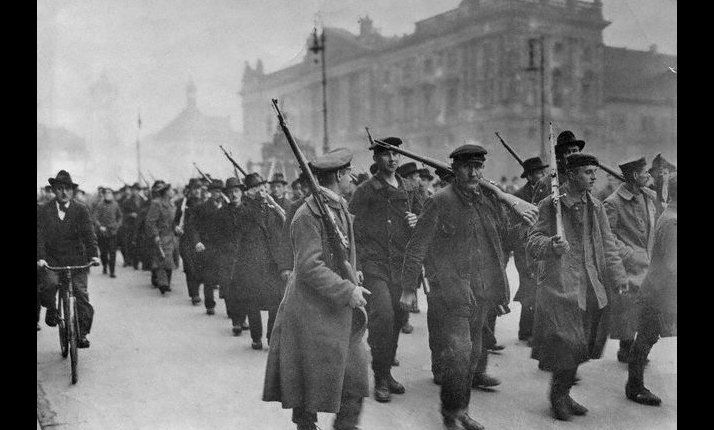By Michael Roberts
This blog was originally published by Michael Roberts on Saturday, 28 September 2024. The original article can be found here. The featured image above shows the exit poll figures after Michael’s blog was written.
**************
On Sunday, Austria has a general election for its parliament. The 183 members of the National Council are elected by open list proportional representation at three levels; a single national constituency, nine constituencies based on the federal states, and 39 regional constituencies. Seats are apportioned to the regional constituencies based on the results of the most recent census. For parties to receive any representation in the National Council, they must either win at least one seat in a constituency directly, or clear a 4 percent national electoral threshold. Around 6.3 million adult Austrians can vote.
The latest opinion polls indicate that the neo-fascist Freedom Party (FPÖ), founded in the 1950s by former SS officers will end up being the largest party at 27%, just ahead of the conservative People’s Party (ÖVP) at 25%, who currently lead the incumbent coalition government with the Greens. The Social Democrats (SPÖ) are running third with 21%. FPÖ leader Herbert Kickl wants to be Chancellor (prime minister) and uses the term “Volkskanzler,” or chancellor of the people, first used by the Nazis and Adolf Hitler in the 1930s.
What is the likely coalition government if the FPÖ wins most seats?
If the FPÖ does get the biggest vote share, it could be in a position to lead a new government – except that up to now the leaders of the ÖVP and the Social Democrats are refusing enter into a coalition with the FPÖ (but the conservatives have hinted that they could if the current FPÖ leader Herbert Kinkl is not in the government). The likely result is an ÖVP-FPÖ coalition or for the first time a three-way alliance of the ÖVP with the SPÖ and either the liberal NEOS or the Greens.
The rise of the FPÖ is not new. The FPÖ was junior partner to the ÖVP in the government of the 2010s. But this fell apart when both parties were involved in a corruption scandal that brought down the government and its FPÖ chancellor in 2019. But now everywhere in Europe, ‘hard-right’ parties are gaining ground in response to the so-called ‘threat’ of immigration and the economic stagnation in many European economies. In June, the FPÖ was the largest party for the first time in the European Assembly election, which also brought gains for other European far-right parties.
Growth of far right linked to stagnation and inflation
Austria has only 9 million people, but over the past decade the country has taken in more refugees per capita than any other EU country, fuelling the FPÖ’s resurgence. The FPÖ has now evolved into a kind of anti-migrant, anti-Islam ‘populist’ party, as seen elsewhere in Europe. The FPÖ wants to end immigration and ‘remigrate’ immigrants to their ‘home’ countries. “Remigration is long overdue!” proclaims Kickl. The FPÖ also hints at leaving the EU, or “Öxit,” an Austrian-style Brexit.
But as elsewhere in Europe, the rising support for hard right anti-immigration parties is as much to do with the stagnation in the major economies and high inflation eating into living standards. It can be said that if Germany has a cold, Austria will get the flu. And Germany is suffering from a very heavy cold for its economy right now. As a result, the spillover to Austria is heavy.
Immigration helped real GDP growth
Austria’s real GDP growth is stagnating at best. Indeed, ironically, if it were not for immigration (+6.3% in 2011-2020), real GDP would have fallen sharply, as the domestic population is shrinking and ageing. Austria will have the third highest old-age related costs in the European Union as a percentage of GDP by 2030.
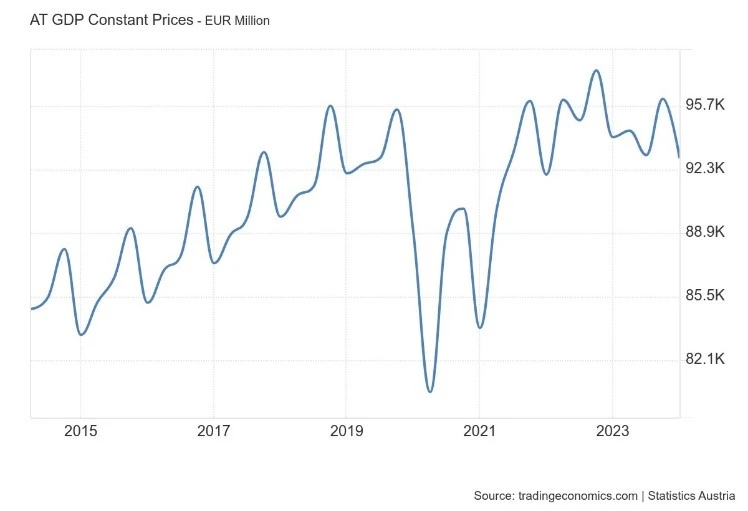
Moreover, Austria is still experiencing high inflation, averaging 4.2% over the past 12 months, surpassing the EU average. Inflation remains high because Austria has been forced to reduce its imports of cheap Russian gas as part of EU sanctions against Russia over Ukraine. Austria is caught in the middle over trade with Russia and with Western Europe.
GDP growth is stagnating
The economy was in outright recession in 2023. The Austrian central bank, the OeNB, now expects the economy to ‘stabilise’ this year, with real GDP up by just 0.3%. Even that looks optimistic. Austria’s GDP fell 0.6% Q2 2024, following a downwardly revised 1% contraction in the previous Q1. Recession continues.
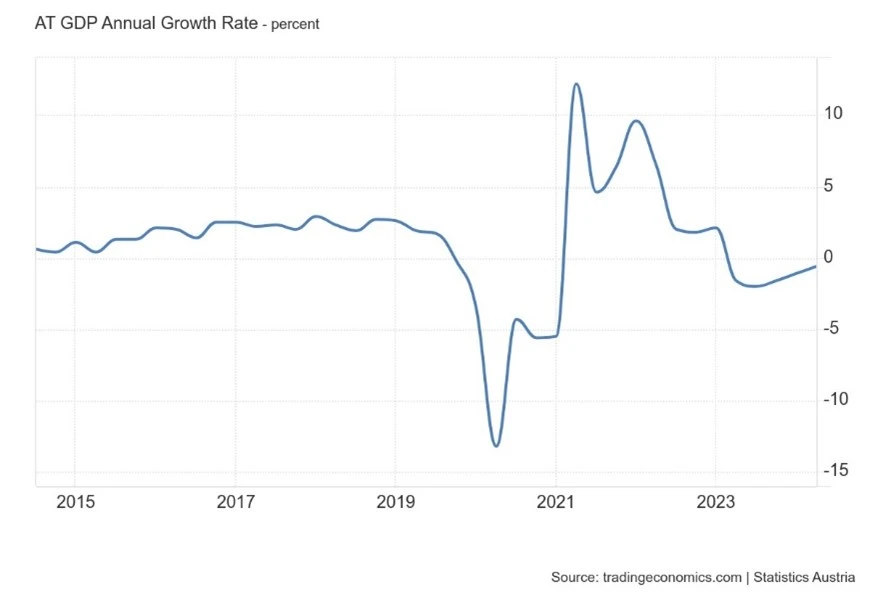
Austrian capital is struggling. Manufacturing is in deep recession (anything below 50 in the graph below means contraction), as it is in Germany.
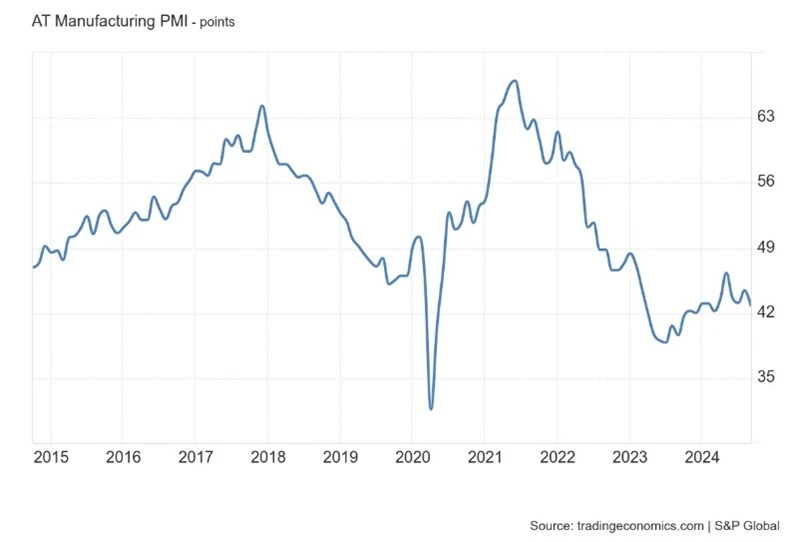
Austria’s real GDP per capita growth stagnated nationwide in 2011-2020 and was lower than the EU average (0.6%) in all regions. Labour productivity is stagnating or decreasing in most regions. That’s because productive investment is still shrinking, after falling 2.3% in 2023.
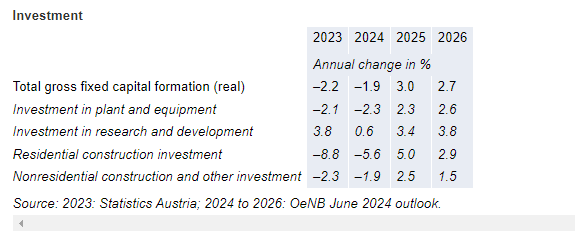
Wages rising fast but not making up for past inflation
Austrian capital is being squeezed because, alongside falling labour productivity, there are rising wages for Austria’s organised workers, the fastest wage rise in Europe this year. Workers try to restore the losses in real incomes they have suffered from high inflation rates after COVID. Even though wages are set to rise by 8.5% this year, that still does not compensate for previous years’ high inflation. And although unemployment is still near lows, new jobs are mainly part-time without any permanent career prospects and pay poorly.
Behind falling productive investment and labour productivity is the fall in the profitability of Austrian capital, mirroring that in Germany. The rise in the early 2000s has given way to steep decline in the 2010s, accelerating since COVID.
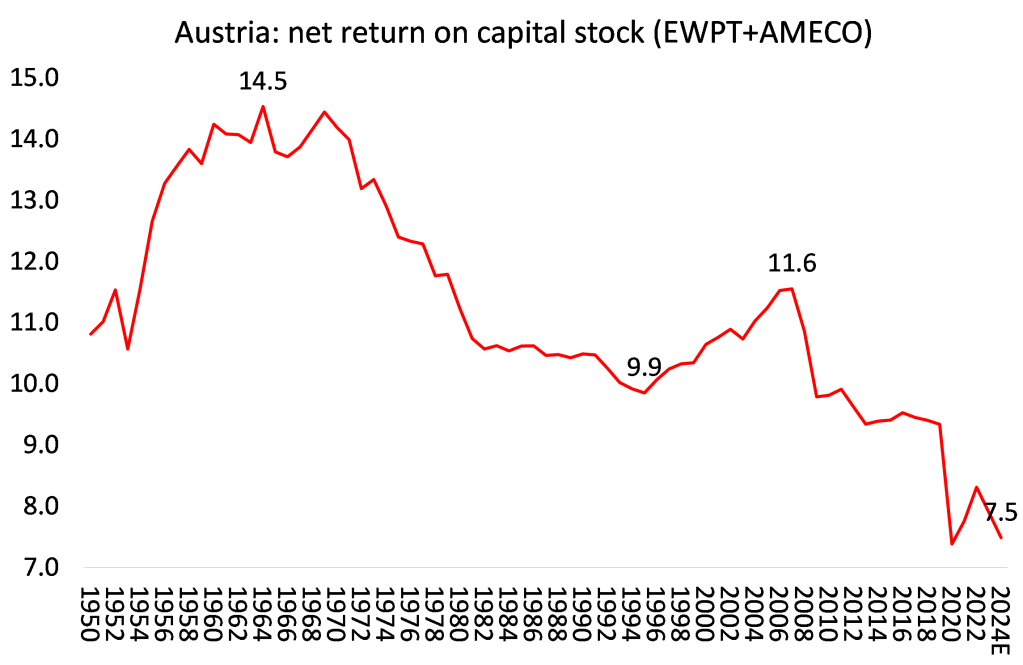
The policies of the FPÖ, ÖVP and Social Democrats
What are the solutions offered by the parties to this economic stagnation? The FPÖ has a mix of neo-liberal, pro market policies with some support for older Austrians, who generally vote for it, like raising state pensions rates. The FPÖ wants ‘more deregulation’ and lower taxes, including cutting corporation tax on small businesses from 23% to 10%; and ending ‘green’ measures by scrapping a tax on carbon emissions introduced in 2022. It advocates price controls during times of severe inflation on food, rent and energy as well as reducing sales tax on essentials. And it wants to maintain Russian energy imports.
The Conservative ÖVP wants to do pretty much the same things as the FPÖ, except it wants to keep to EU sanctions on Russia by ‘promoting renewable energy’. The Social Democrats want some new taxes on the wealthy to pay for tax cuts for the rest of Austrians and they would raise corporate tax and place a one-off levy on energy companies and banks; with a state company to invest in renewable energy to reduce dependence on Russian gas.
None of these policies offer any probability of raising investment rates or productivity, let alone increasing real incomes for most Austrians. So any coalition formed after this election, whether led by the FPÖ or the ÖVP, will change little.
From the blog of Michael Roberts. The original, with all charts and hyperlinks, can be found here.



